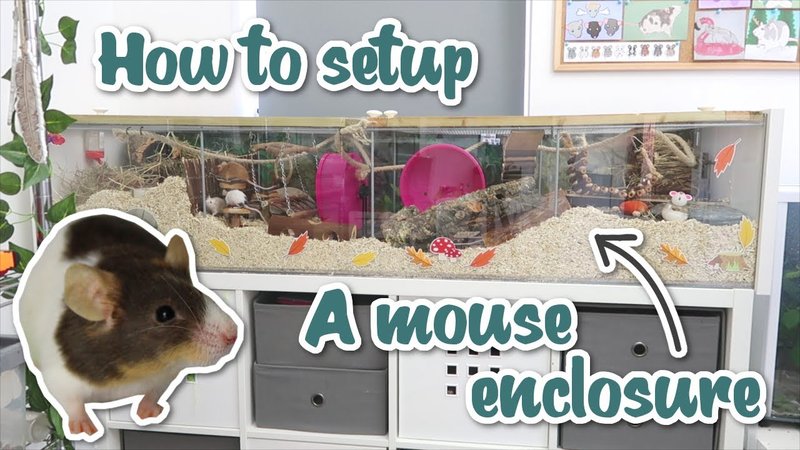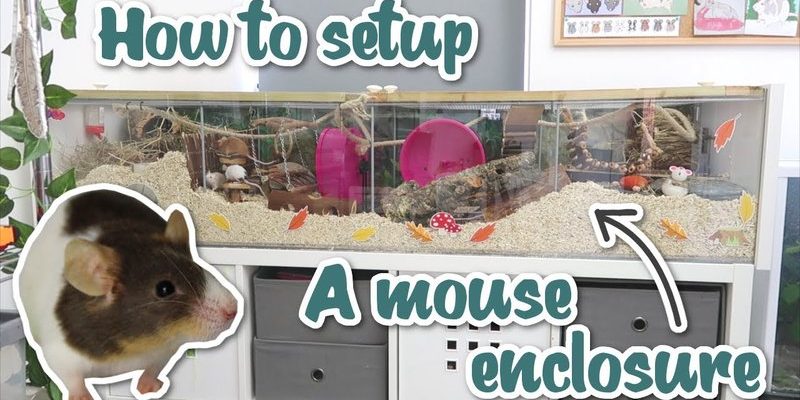
In this guide, we’ll dive into the essential components of mouse care, including the best cage setup, a balanced diet, and ways to keep your little buddy engaged and happy. Whether you’re a brand-new mouse owner or just looking to enhance your pet’s quality of life, you’ll find everything you need right here. So, grab a cup of coffee and let’s get started on this tiny adventure!
Cage Setup: The Home Sweet Home for Your Mouse
The first step to happy mice is creating the perfect living space for them. Think of their cage as a tiny apartment—nice and cozy, but also functional. Size matters! A good rule of thumb is that the cage should be at least 24 inches long and 12 inches wide. Mice love to move around, so a bigger cage is always better.
When choosing a cage, look for one with multiple levels and good ventilation. Wire cages are often recommended since they allow for airflow, but make sure the bars are close together—mice are clever little escape artists! You can also opt for a glass aquarium, but ensure it has a mesh lid for ventilation.
Next up are the bedding and accessories. Use aspen shavings or paper-based bedding—these are safe and absorb moisture well. Avoid cedar or pine shavings, as they can be harmful to your mouse’s respiratory system. Add some tunnels, chew toys, and a hiding space in the cage. These will make your mouse feel secure and provide plenty of exploration opportunities!
Diet: What to Feed Your Standard Mouse
Feeding your mouse a balanced diet is crucial for its health. Imagine trying to function on just snacks! While your little friend might enjoy the occasional treat, it needs a variety of foods to thrive.
Start with a high-quality commercial mouse food. These pellets or blocks are formulated specifically for mice and provide the right balance of nutrients. You can usually find these at pet stores or online. Look for those with whole grains, seeds, and minimal fillers. A good protein source is essential, especially if your mouse is growing or pregnant—check for options that contain protein-rich ingredients like mealworms or soy flour.
You can spice things up by offering fresh fruits and vegetables as treats. Think about small bits of carrots, peas, or apples. Just avoid citrus fruits—they can upset your mouse’s stomach. Remember, though, treats should only make up about 10% of their diet. Lastly, always make sure your mice have access to clean, fresh water. A water bottle tends to be cleaner than a bowl, but either option must be checked and refilled regularly.
Enrichment: Keeping Your Mouse Mentally and Physically Stimulated
Mice are not just cute; they’re also curious! To keep their spirits high and their minds sharp, enrichment is key. It’s like giving your mouse a little adventure every day.
Start by adding different items to the cage that encourage exploration and play. Tunnels, climbing structures, and chew toys are essential. Mice love to dig and hide, so crumpled paper or cardboard boxes can become delightful playgrounds. You might want to switch things up regularly to keep their environment fresh and exciting.
Consider daily interaction, too. Spend time handling your mouse gently to help it get used to you. Creating a routine with playtime outside the cage can build trust and keep your mouse social. Just ensure the area is safe and mouse-proofed—no cables or small hiding spots where they can escape!
Another fun idea is creating a simple maze with cardboard or plastic. This not only engages their instincts but also provides exercise. Plus, you get to see how smart they are as they figure their way through!
Health Monitoring: Keeping Your Mouse in Top Shape
Regular health checks are vital to ensure your mouse is thriving. It’s like keeping a close eye on a friend who might not always speak up about feeling off. You should look out for signs that something might be wrong, such as changes in appetite, weight loss, or unusual behaviors.
You might be wondering how often you should check up on them. At least once a week, handle your mouse gently, and observe how it moves. A healthy mouse is usually active and curious. If your mouse appears lethargic or has discharge from its eyes or nose, it’s time to consult a vet who specializes in small animals.
It’s also worth noting that mice have a natural lifespan of about 2 to 3 years. As they age, they might experience issues like dental problems or tumors, so stay alert and responsive to their changing needs. Regular vet visits can also ensure your mouse stays on track.
Cleaning the Cage: Keeping It Fresh and Safe
Just like anyone, your mouse benefits from a clean living environment. A regular cleaning schedule prevents odors and keeps your furry friend healthy. It’s easier than you might think, and your mouse might even appreciate a fresh start!
Aim to spot-clean the cage daily by removing any soiled bedding and uneaten food. For a thorough clean, deep clean the cage once a week. Begin by taking your mouse out (safely in a carrier or secure play area) and removing all bedding and items from the cage. Use warm, soapy water to scrub down the interior, and rinse it thoroughly to avoid any residue.
Once it’s dry, replace the bedding, and put all the toys and tunnels back. Give your mouse a moment to explore the newly cleaned space—it’s like redecorating their home! A fresh cage can really keep their spirits up.
Special Considerations: Pairing and Socialization
Mice are social creatures, and they often do best when they have a companion to play with. Think about how you enjoy spending time with friends; your mouse likely appreciates the same! However, it’s essential to house mice in pairs or small groups of the same sex to prevent breeding.
When introducing new mice, do it gradually. Start with a neutral space where neither mouse has established territory. This helps avoid fighting and territorial disputes. You’ll also want to keep an eye on their interactions for the first few days to ensure everyone gets along.
If you decide to have a single mouse, be extra attentive. Spend plenty of time with it daily to encourage bonding. Engaging with toys and hideouts can also prevent the loneliness that comes with being solo.
Caring for a standard mouse can be a rewarding journey filled with fun and discovery. By setting up a comfortable cage, providing a balanced diet, and enriching their lives through play, you’ll create a thriving environment for your little buddy. Remember, each mouse has its own personality, and getting to know them is part of the joy of pet ownership.
As you embark on this adventure, keep in mind that patience and love go a long way. Your effort in understanding and meeting their needs will not only keep your mouse healthy but will also form a special bond that lasts a lifetime. So go ahead—dive into this charming world of mice care, and watch your tiny friend flourish!

